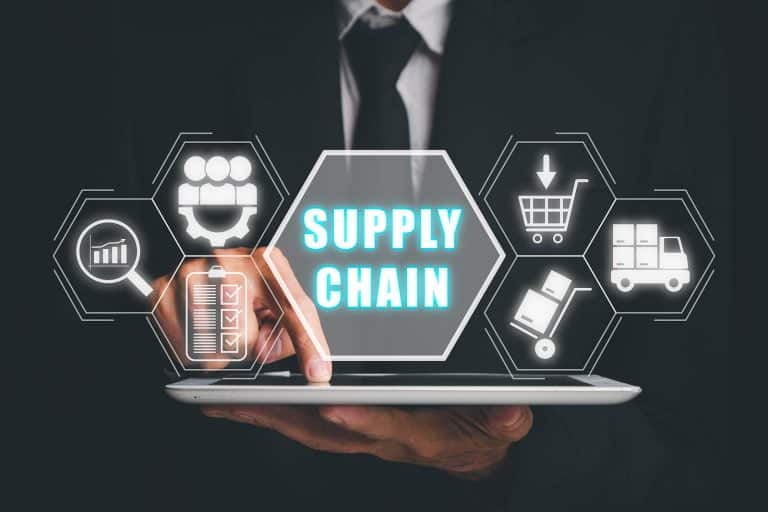Read on to learn about cost factors that comprise blockchain app development.
Table of Contents
ToggleWe use traditional applications daily, whether to write an email in a web browser interface or check the weather on our mobiles. These applications have one thing in common: they rely on servers to synchronize data.
A blockchain development company develops and tests blockchain apps that operate on peer-to-peer networks without central servers. Their operation depends on consensus among blockchain participants, and there is no need for a central authority. Blockchain applications run on several platforms at once – on a blockchain (in the form of a smart contract) and in mobile or web applications. Therefore, when you create a blockchain application, you rarely end up with just one application. As blockchain applications strive to put the power back in the user by cutting out the middleman and building trust through automated distributed cryptography.
Why do we even need blockchain application development services? After all, we already have a myriad of apps for just about everything. There must be some benefits for switching to Blockchain applications.
A blockchain application can have absolutely all the functionality that regular apps have had for years. Let’s think for a moment about a decentralized Uber application? Is it possible? Yes. This decentralized Uber would have all the functionality of the standard Uber app, including payments, search, messaging, notifications, and more with an additional layer of security that the blockchain technology promises.
All we are emphasizing here is that it’s hard to describe the functionality of a “typical” blockchain based app, because it could be anything, right? Still, there are specific features that all Apps must have to get traction. What is that?
1) Centralized Servers: Since onboarding the user to any blockchain application starts with connecting a crypto wallet, it becomes an essential part of any software running on a blockchain.
2) Intelligent Contract Transactions: Your customers will need a wallet to receive bonuses and rewards in the form of virtual money, currencies or non-fungible tokens.
3) Decentralized Oracles or Nodes :Like any standard application, you expect a dApp to perform specific actions. The only difference with “normal” applications is that decentralized applications require transactions to function.
As already mentioned, besides these fundamental features, a blockchain application can have absolutely all the features that we often find in other traditional applications. Let us dive into the cost factors that comprise these various features.
Key Cost Features of a Blockchain Application
Blackchain App Development Factor# 1 Plan capacity and density
Anyone who follows blockchain technology knows the enormous energy and power requirements of calculation associated with Bitcoin and other cryptocurrencies that have introduced the concept of blockchain. These significant needs, w.r.t infrastructure, arise from mining activities of the type Proof of Work (PoW) which oblige users wishing to increase their cryptocurrency holdings to solve complex cryptographic problems requiring several gigantic calculation cycles.
Commercial blockchain applications will nevertheless be very different from cryptocurrencies and, therefore, will not require the computational power of Proof-type mining work but will still require high computing power for the hashing and cryptography needed to establish and
maintain trust in blockchain networks.
Some blockchain networks use mechanisms similar to PoW, whose computational needs prevent attacks on the trust of widely distributed blockchains. Others, instead, adopt Proof of Stake or Proof of Authority. In a private blockchain, a central body can ensure trust in the identity of users while preserving the distributed ledger model for tracking transactions.
Regardless of the model chosen for an application given commercial blockchain, its success will be based on computationally demanding cryptography because:
1) The basis of trust in these networks is the creation of a hash in every new block, and
2) Blockchains keep getting lengthened over time.
Although the hardware capacity required to run high-volume commercial blockchain applications from long-term transactions is unknown, it is probably considerable. Therefore, if your organization intends to get involved in blockchain trials, it is vital not to underestimate the following:
- The capital cost (or operating cost if using an IaaS model, i.e., infrastructure as service) for computing, storage, and I/O capabilities is required for long-term blockchain participation.
- Associated operating costs for power, air conditioning, and rack space.
- Other ownership costs associated with monitoring
- Systems, operating system patches more.
- Aggressive, log capture, troubleshooting systems, etc
- Additional processing and network capacity.
Processors’ highly variable power consumption during intense cryptographic computational peaks and connecting them to ERP systems.
We will know more about the exact power requirements and costs in these areas as applications of commercial blockchains are spreading and adopting models of more standardized hashing and cryptography. But if we deploy our blockchain infrastructure on-site in the cloud or according to a hybrid model, an enterprise should maintain its total cost of ownership in the long term.
Blackchain App Development Factor #2: Infrastructure segmentation
DevOps practices have emerged to address a significant factor in the relationship between infrastructure operators and developers. They collaborate with the sales teams to speed up the creation and updating of applications and “drop” the new codes to operators.
This created various problems: technical hiccups during the deployment of new code in the production phase and unplanned infrastructure costs.
DevOps addresses this problem by improving collaboration between developers, operators, and quality assurance personnel, as well as streamlining the process by which ideas
become real applications in the production phase.
Similar problems arose when technologies like analytics, machine learning, and AI became widespread. Here, commercial users and experts in data science have often been engulfed in new advances without sufficiently considering the implications for infrastructure, which can be regarded as an issue of bringing together vast volumes of scattered data, processing them with complex algorithms, and then providing sophisticated illustrations of the results.
To solve these scaling issues, organizations have adopted DevOps-like collaborative practices, such as DataOps (for Big Data processing) and AIOps (to support the intensive algorithmic processing of this data).
We observe the same problem with the blockchain Commercial players and blockchain technology SMEs urgently launching new application pilots, hardly ever including operating personnel infrastructure. One of the reasons is that practices such as server and storage virtualization have made it too easy to operate through the flexible allocation of capacity to applications traditionally depending on demand. But a blockchain behaves very differently from deterministic applications, traditional and new-wave systems, and non-deterministic AI/machine learning.
For instance, since blockchain applications often depend on real-time responses to hash requests for new transactions, the smallest denomination or server power instability can interrupt the critical cryptographic process at the worst time.
To eliminate this risk, it may be that, unlike other infrastructures, the blockchain infrastructure must be equipped with uninterruptible power supplies.
These specificities suggest that, in addition to being included the earliest possible in discussions about potential blockchain pilots, infrastructure operations managers must also segment the blockchain pilots on racks separately and dedicated to specific purposes as much as possible. This kind of segmentation offers multiple advantages:
- Good visibility of behaviors and workloads
- Specific to blockchain applications.
- Ability to test infrastructure configurations
- Blockchain specials, including air conditioners,
- Power supplies and electricity meters and processors specialized.
- Absence of negative impact of the behaviors of the blockchain infrastructure (and potentially volatile) on other commercial applications.
Blackchain App Development Factor #3: Governance and Audit
Third-party players’ role in a blockchain project is not limited to performance, reliability, and
cost. It is also necessary to assess the significant safety issues and compliance and even the integrity of the data center itself. From a security point of view, blockchain technology is far
from being tested. The extensive computing power requirements of the “Proof of Work” algorithm are certainly a protection against DSD (distributed denial of service) attacks, but this is not a guarantee against hackers. On the contrary, highly publicized cryptocurrencies have already proven that blockchain applications are just as vulnerable to faulty coding and inadequate identity checks as any other type of software.
As the use spreads and the stakes grow, more sophisticated attacks are almost inevitable.
From a compliance perspective, regulatory agencies are already very concerned about blockchain technology. Without a centralized point of control, blockchain applications pose
new challenges for compliance auditors. Because many blockchain variants allow anonymity and identity masking that facilitates the circumvention of regulations.
Because of this potential increased risk of misconduct, regulatory agencies may impose stringent audit criteria for blockchain users, particularly in highly regulated sectors such as health and financial services.
Along with the need to rigorously control blockchain activities to ensure compliance with regulations, internal governance imperatives also require providing continuous real-time and historical visibility of activity blockchain infrastructure. This visibility is necessary to control the risk of human error to estimate the actual cost of participation in a blockchain and to establish best practices capable of continuously reducing the cost and bet as the company engages in an increasing number of different blockchains.
For these and other reasons, good auditing practices and blockchain governance include:
- Robust capture of all activity logs, blockchain systems, and related audit data.
- Physical security at the rack level and logging all remote and on-site maintenance activities.
3. The use of analytical and science techniques data to detect trends and deviations from behavioral references.
4. Blockchain-specific escalation procedures for alerting ICT players, sales representatives, and managers of the risk about notable trends and events.
All these good governance practices and auditing are supported mainly by the excellent approach previously suggested in the infrastructure segmentation of this article.
Blockchain App Development Cost
The cost of developing a blockchain application varies according to its complexity. For example, a less complex project can range from $15,000 to $35,000. On the other hand, the cost of a moderately complex blockchain app ranges from $30,000 to $90,000. Finally, the price of a complex project can reach $150,000, or even more. These amounts can also vary depending on whether the professional is a beginner or experienced.
What’s interesting about Blockchain applications over traditional applications is that they often look alike to users. The only advantage is that blockchain applications still have a built-in crypto token and business model, but again there are many centralized traditional applications that deal with cryptography and still rely on private servers. Nevertheless, these prices vary enormously and are constantly scaling in the market due to the type of development to be implemented.
In conclusion, the cost of developing a blockchain-based app is highly variable. This variability is linked to several factors, including the skills required, the geographical position, the developer’s experience level, the gap between demand and supply, etc. Therefore, properly assessing project requirements is essential.




